
Carignan is a red grape variety of Spanish origin that is more commonly found in French wine but is widely planted throughout the western Mediterranean and around the globe. Along with Aramon, it was considered one of the main grapes responsible for France's wine lake and was a substantial producer in jug wine production in California's Central Valley but in recent years, it has been reborn as a flagship wine for many cellars in the south of France as well as in Catalonia.

Vidal blanc is a white hybrid grape variety produced from the Vitis vinifera variety Ugni blanc and another hybrid variety, Rayon d'Or. It is a very winter-hardy variety that manages to produce high sugar levels in cold climates with moderate to high acidity.
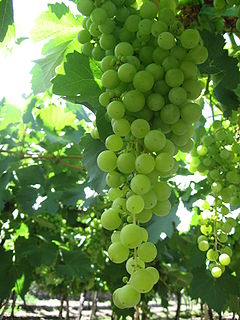
Torrontés is a white grape variety, mostly produced and known in Argentine wine, producing fresh, aromatic wines with moderate acidity, smooth texture and mouthfeel as well as distinctive peach and apricot aromas on the nose. Three Torrontés varieties exist in Argentina: Torrontés Riojano, the most common, Torrontés Sanjuanino, and Torrontés Mendocino. It is primarily Torrontés Riojano that has received attention for the quality of its wines, and is the variety used for most Argentine wines simply labeled Torrontés.

Fer is a red French wine grape variety that is grown primarily in South West France and is most notable for its role in the Appellation d'Origine Contrôlée (AOC) wines of Gaillac, Marcillac and Béarn but can also be found as minor component in the wines of Madiran, Cabardès and Bergerac. The grape is also featured in red blends from several vin de pays regions in the south west with significant plantings coming from the Aveyron department.
Peloursin is red French wine grape variety best known for crossing with Syrah to make the red wine grape Durif. The variety is believed to have originated in Isère from the northern Rhône-Alpes region. Today Peloursin can be found in some quantities in California and in the Australia wine region of Victoria.
Ribolla Gialla is a white wine grape grown most prominently in the Friuli region of northeast Italy. The grape is also found in Slovenia where it is known as Rebula. In Friuli, the grape thrives in the region around Rosazzo and Gorizia. In Slovenia, the grape is grown prominently in the Brda region. The grape is not related to the Friuli red wine grape Schioppettino, which is also known as Ribolla Nera. The obscure, lower quality Ribola Verde grape is a mutated version that is not widely used.

Fiano is a white Italian wine grape variety that is grown primarily in the Campania region of southern Italy and on the island of Sicily. In Campania, this fairly strong flavored white wine grape is particularly noted around Avellino where the Denominazione di origine controllata e Garantita (DOCG) wine of Fiano di Avellino is produced. The grape has a long history in the Campanian region and is believed to have been the grape behind the ancient Roman wine Apianum. Even today, the name Apianum is permitted to appear on wine labels of the DOCG wine Fiano di Avellino.
Biancame is a white Italian wine grape variety that is grown in the Marche and Emilia-Romagna regions of Italy. Here it is an important component in the Denominazione di origine controllata (DOC) wines of Bianchello del Metauro and Colli di Rimini.
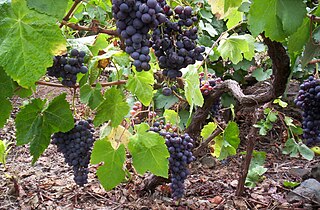
Listán Negro is a red Spanish wine grape variety that is widely planted in the Canary Islands, particularly on the island of Tenerife where it is a permitted variety in the Denominaciones de Origen (DO) wines of Tacoronte-Acentejo, Valle de la Orotava, Ycoden-Daute-Isora, and Valle de Güímar. It is also permitted in the Spanish wine regions of El Hierro, Gran Canaria, La Gomera, La Palma, Lanzarote. Across the Canary Islands more than 5,000 hectares are planted to the variety.
Terrantez is a white Portuguese wine grape variety that was once widely used on the island of Madeira to make the sweet fortified wine for which the island is known. Today, the variety is nearly extinct on the island. There are still some limited plantings in the Minho Province where, as Cascal, is a permitted blending variety with Alvarinho and other grapes in the Denominação de Origem Controlada (DOC) wine Vinho Verde. As Terrantez the grape is permitted in several of the Indicação de Proveniencia Regulamentada (IPR) regions of the Azores including Biscoitos IPR on Terceira Island, Graciosa IPR on the white island of Graciosa and Pico IPR on Pico Island.
Saint-Pierre Doré is a white French wine grape variety grown primarily around the Saint-Pourçain AOC in the Auvergne region of Central France. While the grape has a long history in the region of being very productive and producing high yields, its plantings have been steadily declining over the last century and now the variety is almost extinct.
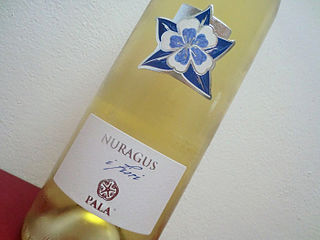
Nuragus is a white Italian wine grape variety that is grown in Sardinia. It is the principle variety between the Denominazione di origine controllata wine Nuragus di Cagliari. The grape has a long history on the island with ampelographers believing that the variety was likely introduced to the area by the Phoenicians. While the grape is still widely planted in Sardinia its numbers began to dwindle in the late 20th century, falling by 50% during the 1980s alone to a total of 8,700 hectare in 1990. Today it is mostly found in the southern part of the island between Cagliari and Oristano on the hot Campidano plain.
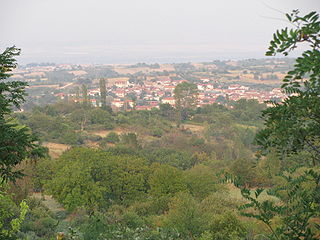
Negoska is a red Greek wine grape variety (Negushka) that is grown primarily in "Central Macedonia". Around the town of Goumenissa the grape is blended with Xynomavro to produce very fruity wines with high alcohol levels.

Gouget noir is a red French wine grape variety that is grown in the Allier and Cher departments of central France. The grape was once widely planted with almost 17,000 hectares in the mid-19th century but the phylloxera epidemic greatly diminished it numbers and as of 2008 there was just 10 hectares of the grape planted in France.
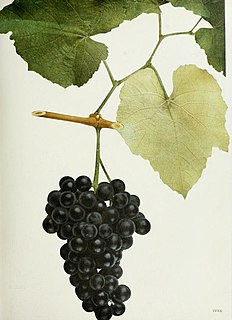
Ives noir is a red hybrid grape variety that is grown throughout the United States. Named after its propagator, Connecticut wine grower Henry Ives, the grape's pedigree and exact origin are unclear. After Prohibition in the United States, Ives was a popular grape used in the production of sweet port-style wines but saw its plantings steadily decrease throughout the 20th century as the vine's susceptibility to air pollution took its toll.
Rossola nera is a red Italian wine grape variety that has been growing in the Valtellina region of Lombardy since at least the 17th century. In 2004 DNA profiling determined that the grape has a parent-offspring relationship with the Piedmont wine grape Nebbiolo though which variety is the parent and which is the offspring is not yet clear. However, most ampelographers believe that Nebbiolo is likely the parent variety since written records in Piedmont have noted Nebbiolo being grown since at least the 13th century.
Landot noir is a red hybrid grape variety that is a crossing of Landal and Villard blanc. Created after a series of trials between 1929-1949, the grape was introduced to Canada and the United States in the 1950s and today can be found in Quebec as well as New Hampshire where a varietal is produced by Jewell Towne Vineyards.

Muscat bleu is a red Swiss wine and table grape variety that is a hybrid of Garnier 15-6 and Perle noire. The grape was developed in Peissy in the Canton of Geneva by Swiss grape breeder Charles Garnier in the 1930s. Today the grape is used as both a table grape and for winemaking, producing wines that Master of Wine Jancis Robinson describe as "soft and grapey". Outside Switzerland some plantings of Muscat bleu can also be found in Belgium.
Giró blanc is a pink-skinned Spanish wine grape variety grown in the Balearic islands where it used in white wines produced under the Illes Balears appellation. Ampelographers believe that the grape is indigenous to Majorca with DNA profiling showing no known relationship to the Sardinian wine grape Girò or to Grenache which is known as Girò on Majorca.
Albanella is a white Italian wine grape variety that is grown in the Marche region where it is a primary component in the white Denominazione di Origine Controllata (DOC) wines of Colli Pesaresi. The grape is often confused with the similarly named Sicilian wine grape Albanello and was long thought to be identical to the Tuscan wine grape Trebbiano but has established through DNA analysis to be its own distinct variety.











